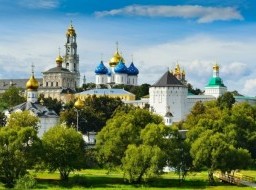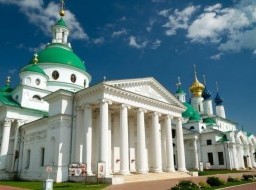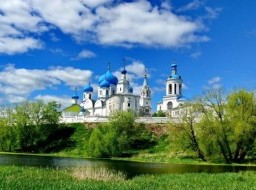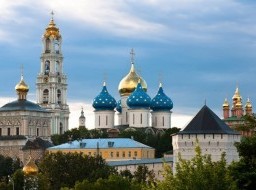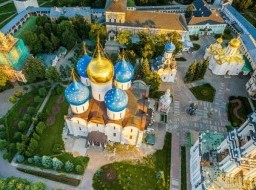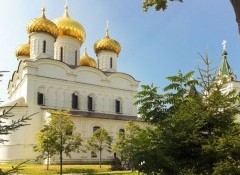Dmitrievsky Cathedral
At the time of the reign of Grand Prince of Vladimir Vsevolod the Big Nest, Vladimir-Suzdal Princedom was in the zenith of its glory. “Suzdal Region back in the beginning of XII century was a forsaken north-eastern corner of Russian Land, but in XIII century was already a Princedom that decisively headed up the rest of Russ,” V. Klyuchevsky wrote. And Dmitrievsky Cathedral built by Vsevolod was purposed to signify this rise of Vladimir Land. The exact time of the construction of the Dmitrievsky Cathedral is unknown. A Vladimir’s chronicler, speaking about the death of Grand Prince Vsevolod III the Big Nest, mentioned only that the prince created in his court “a beautiful church” named after martyr Dmitry and wonderfully decorated it with icons and paintings. Historians believe that the cathedral was built between 1194 and 1197. It was erected by Russian masters, – the chronicler especially emphasizes that “no foreign masters were looked for” for the building of the Dmitrievsky Cathedral. The temple was built as a palace-church of Grand Prince Vsevolod the Big Nest. This time was marked with a number of tremendous construction projects, among which the Dmitrievsky Cathedral holds one of the first places. The cathedral is a masterpiece of harmony and measure. Decency of forms and ideal proportions make the Dmitrievsky Cathedral unique. The cathedral is magnificent. The spirit of solemnity permeates it in every small detail. Everything that was prominently done in Russia in filigree work, engraving, enameling and, especially, wood carving found its place in painting and decorative motifs of the Vladimir’s architects. Because of abundance of whitestone carving that covers the walls of the cathedral, it is called “the precious chest,” “the stone carpet,” “the stone poem.” Richness of its ornamentation is so great that, it seems, it would have become extreme if the builders and stone engravers had been deprived of the sense of harmony that allowed them to stop at the very moment when the highest supreme limit was reached, after which bizarrerie would have followed. The facades of the building are divided into three levels. The lowest one is almost deprived of decoration and only carved prospective portals stand out on the background of its flat walls. The middle level is a column-like arkatur belt with whitestone carved figures and rich ornamentation. The upper level with cut-through narrow high windows is completely covered with carving. The carving covers the drum of the dome as well. The temple is crowned with a not very steep gilded dome that resembles a knight’s helmet. An azure wide cross made of cut gilded copper is installed upon it. The fact that the lower level of the Dmitrievsky temple is void of any ornamentation is quite explicable. The thing is that it was originally closed by galleries that surrounded the cathedral on three sides. While from the main, western façade, at the corners of the galleries two stair towers stood resembling the towers of Kiev’s Sofia Cathedral. The galleries and towers were also ornamented with whitestone carving. But the cathedral’s appearance has not been preserved to our days. The main figure in the system of the ornamental decoration of the Dmitrievsky Cathedral is the figure of King David that occupies the central place in each of the three facades of the temple. The image of king-psalmist David is crucial for comprehension of the symbolism of the whitestone carving of the cathedral: “May every breath praise the Lord!” An illustration to these words of David’s psalm are all the characters of the Dmitrievsky’s relieves. This statement is sometimes object to questioning with arguments that “among the relieves there are too many fierce predators, malignant horsemen, scenes of strife and bloodshed.” That is right, fierce predators, malignant horsemen are there… but it is written, “May every breath praise the Lord!” “Every!” as for the scenes of strife and bloodshed, “If I descend into Hades – and You are there” as another spiritual Scripture says. The world of human beings, the animal world is presented on the walls of the cathedral in all their controversies. But just like these images are united by the Dmitrievsky Cathedral, so the world woven of controversies is embraced by God together with all the existing in these world controversies – both the psalmists and the malignant horsemen… |

